 Cosmic Ultraviolet Radiation and the Earth's atmosphere
Cosmic Ultraviolet Radiation and the Earth's atmosphereIn this cartoon, a distant spiral galaxy is radiating energy at all wavelengths of the electromagnetic spectrum. For groundbased observers beneath the Earth's atmospheric blanket, only certain segments of this spectrum are accessible. The visible-light portion is most familiar to us, because it is what our eyes detect as red, orange, yellow, green, blue, indigo and violet. Beyond the red and into the infrared, water vapor and other gases in the troposphere absorb the IR photons, prevent their transmission to the Earth's surface. Beyond the violet and into the ultraviolet, ozone molecules in the stratosphere effectively absorb the UV photons. Were this not so, the Sun's output of UV radiation (though considerably weaker than its visible-light output) would be sufficient to irreparably burn all soft-skinned creatures---including ourselves! Because the Earth's atmosphere is so opaque to UV photons, one must carry out UV astronomical observations from platforms placed above the bulk of the atmosphere. This was initially done using high altitude balloons and sounding rockets. More recetly, UV telescopes have been placed in Earth orbit abord "permanant" satellite platforms. These include the International Ultraviolet Explorer (IUE) satellite (which has been obtaining high-quality UV spectra since 1983), the Hubble Space Telescope (which has both visible and UV observing capabilities) and the Spacelab/Astro-1/UIT experiment described below.
 Astro-1 in the
Space Shuttle Bay---Fully Deployed
Astro-1 in the
Space Shuttle Bay---Fully DeployedThis view of the Astro observatory was taken from the aft window of the Space Shuttle Columbia. At the time, Columbia aws on the day-side of the Earth, with the instruments fully illuminated by the Sun. The Ultraviolet Imaging Telescope is the large cylindrical telescope which is blanketed with thermal insulation. The three smaller cylinders to its left are the star trackers which help keep the entire observatory pointed to the desired astronomical targets. The slender conical telescope on the right is another star tracker, which provides data to the individual telescopes for fine pointing adjustments.
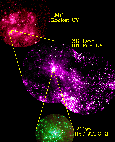 Anatomy of a Starburst--- the 30 Doradus Supercluster
Anatomy of a Starburst--- the 30 Doradus Supercluster
For low-mass stars like the Sun, the basic job description is to ``live long and prosper.'' This is done by fusing hydrogen into helium in the stellar core at a rate that can be sustained for billions of years. By contrast, the job description for stars containing more than five Suns worth of mass is to burn at drastically enhanced rates for a few million years and then die in violent supernova explosions (see the Crab Nebula and the Cygnus Loop). These comparatively rare stars can individually outshine more than 100 thousand Suns. Most of this luminosity comes out in the form of ultraviolet photons which interact strongly with any gas and dust that is in the vicinity. Since these massive stars last only a few million years, they generally remain close to their nebulous birthsites. Such regions of intense starbirth and supernova activity are known as starbursts.
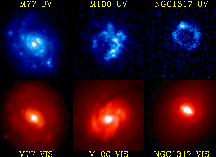 Starburst
Activity in M77, M100, and NGC 1317
Starburst
Activity in M77, M100, and NGC 1317In this gallery of starburst regions, the inner disks of three spiral galaxies are compared. All three galaxies show intense star-forming activity at UV wavelengths. The morphology of this activity differs dramatically from galaxy to galaxy. In M77, the UV-bright knots of starburst activity seem to be closely associated with an inner bar of older stars (shown in red). In M100, which does not have a prominent bar, a UV-bright ring of starburst activity can be seen along the periphery of the galaxy's innermost spiral arms. And in NGC 1317 a circumnuclear ring surrounds the galaxy's central disk, where a bar is clearly evident. From this limited comparison, we can infer that circumnuclear starburst activity occurs with or without a central bar, as well as outside or inside the bar when it is present. Through ultraviolet imaging, the circumnuclear starburst regions can be seen with the highest contrast against the cool star background.
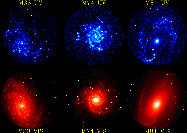 A Sequence
of Spiral Galaxy Types
A Sequence
of Spiral Galaxy TypesLoosely defined, galaxies are self-gravitating realms made up of stars, interstellar gas and dust, plus uncertain amounts of non-luminous (dark) matter of still unknown nature. These island universes come in an amazing variety of shapes --- including bulbous ellipticals, ragged irregulars, grand design spirals (both barred and unbarred), and interacting peculiars. Even among the unbarred spirals, the diversity of structure that is observed presents a challenge to astronomers wishing to understand the origin and evolution of these galaxies.
In this comparison of nearby spiral galaxies, a morphological sequence is evident. At the left, Messier 33 (an Scd spiral) has the loosest spiral windings and least prominent bulge. It is riddled with UV-bright sites of high-mass star formation. In the middle, Messier 74 (an Sc spiral) has tighter spiral windings that are richly populated with giant UV-bright knots of starbirth activity. Its bulge is of intermediate prominence. At the right, Messier 81 (an Sb spiral) has the tightest and narrowest spiral windings which are sparsely populated with much smaller knots of UV-bright stars and associated nebulosity. It harbors the most prominent bulge of cool stars. This sequence of tighter spiral windings, lower starbirth activity, and greater bulge prominence extends to the Sa and S0 type galaxies (whose diminished disks are nearly featureless). Increasing rotation velocities and decreasing amounts of star-forming gas also seem to follow this sequence. Some astronomers interpret these trends in terms of an evolutionary sequence that involves differing star-forming histories. According to this sequence, the Sd spirals are least ``evolved'' in terms of having converted their gas into stars.
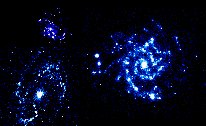 Relative Sizes of
Spiral Galaxies
Relative Sizes of
Spiral GalaxiesGalaxies come in many sizes and masses. At the small end, dwarf irregulars and ellipticals can measure as little as a thousand light years across and contain less than 100 thousand luminous stars. At the other extreme, giant spirals and ellipticals can be 100 times larger and contain upwards of one trillion stars. In this montage, three spiral galaxies are depicted according to their relative sizes. Counterclockwise from the top, they are Messier 33, Messier 81, and Messier 74.
The determination of a galaxy's size depends on its angular diameter in the sky and on its distance. The distances to M33 and M81 are well established from observations of Cepheid variable stars in their disks. These stars are standard candles, known to have absolute luminosities that reliably track with their observed pulsation periods. The Cepheid variable stars in M74 are too far and faint to be observed with groundbased telescopes, and they have yet to be targeted by the refurbished Hubble Space Telescope (which is up to the task). Meanwhile, other less accurate methods must be used to estimate M74's distance. This distance estimate (23 million light years) and the resulting size estimate (68 thousand light years) could be off by a factor of two.
Even with such uncertainties, one can readily see that Messier 33 is dwarfed by the other two spiral galaxies. The UIT image of M33 shows that, despite its relatively small size, it is still capable of fostering many sites of UV-bright starbirth activity. Being the least evolved of the three galaxies, M33 has delayed much of its star formation up until the present epoch. One is tempted to surmise that all small galaxies are slow to convert their reserves of gas into stars. However, the observable universe is full of dwarf ellipticals which were able to transform themselves from gas balls into star balls early in their lifetimes. Other factors, including initial density, rotation rate, and prior interactions may have played important roles in the evolutionary histories of these galaxies.
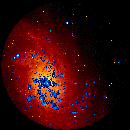 Messier 33 ---
The Pinwheel Galaxy in Triangulum
Messier 33 ---
The Pinwheel Galaxy in Triangulum Barely visible with the unaided eye, Messier 33 is located in the northern constellation of Triangulum --- about 15 degrees away from its larger cousin, the Andromeda galaxy (Messier 31). Its distance of 2.5 million light years is well established from observations of Cepheid variable stars in its disk. This distance places M33 within the Local Group of galaxies, physically closer to the Andromeda galaxy than to the Milky Way galaxy. Through binoculars or a small telescope, the galaxy appears faint and diffuse with very little central concentration. In long exposures taken with a telescope, Messier 33 shows some ragged spiral structure, which has led to it being called the Pinwheel galaxy. Its relatively loose spiral windings and weak central bulge qualify it as a spiral galaxy with an Scd morphological classification (where Sa spirals have the tightest windings and strongest bulges, while Sd spirals have the loosest windings and least prominent bulges).
The Pinwheel contains approximately 10 billion stars, or about 10 times more than the Large Magellanic Cloud and about 20 times less than either the Andromeda or Milky Way galaxies. Because of its relative proximity and significant size, M33 has provided astronomers with a bounty of observable targets... including Cepheid variable stars and other supergiant stars, novae, open and globular star clusters, emission nebulae, and dark clouds of gas and dust.
In this composite image of M33, the visible-light emission is shown in red--yellow colors, while the ultraviolet emission is shown in blue--white tints. The difference between these two emission components is obvious, with the UV emission being most closely constrained to the spiral arms. This segregation of colors tells astronomers that the hottest and youngest stars are most closely associated with the galaxy's spiral structure. Indeed, the dynamics that are orchestrating the spiral pattern are probably responsible for initiating the observed UV-bright starbirth activity along the spiral arms. The segregation also tells astronomers that the spiral arms must be temporary features that move around M33. Otherwise, the accumulation of stars formed during the galaxy's lifetime (seen in red) would follow the same restricted spiral pattern.
To the upper left (northeast), NGC 604, the brightest starburst region in M33, shines with the power of 500 Orion nebulae. Like the 30 Doradus supercluster in the Large Magellanic Cloud, this knot of hot massive stars is probably only a few million years old. By comparing the UV and visible-light properties of NGC 604 with those of the other knots in M33, the Magellanic Clouds, and other nearby galaxies, astronomers hope to establish the primary factors governing starburst activity in more distant galaxies.
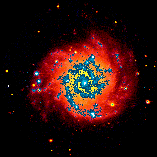 Messier 74 ---
A Grand-Design Spiral Galaxy
Messier 74 ---
A Grand-Design Spiral Galaxy Located in the constellation of Pisces the Fish, the telescopic object Messier 74 is one of the finest examples of a giant spiral galaxy seen nearly face-on. In this composite image of M74, the visible-light emission is represented in red, while the UV emission is shown in blue-white tints. Newborn hot stars and associated nebulosity dominate the near-UV emission. The concentration of this starbirth activity along the spiral arms is indicative of global dynamic processes at work on time scales of about 10 million years --- the approximate time for gas to traverse a spiral arm. The regularity of M74's spiral windings has prompted astronomers to regard it as a grand design spiral galaxy, such that its spiral arms are both well-confined and continuous for more than one winding --- unlike the more ragged spirals seen in M33. Such remarkable coherence in galaxies measuring 70 thousand light years across is thought to be induced by vast waves, known as density waves, that sweep around the disk. When gas clouds orbiting in the disk encounter the spiral-shaped crest of such a density wave, they slow down and converge towards one another. The resulting collisions and mergers of the clouds are thought to incite the starbirth activity that is evident along the spiral arms.
Much of the UV emission from the spiral arms in M74 is concentrated in knots of starburst activity measuring hundreds of light years across. The brightest of the UV knots are as luminous as the 30 Doradus supercluster in the Large Magellanic Cloud. In M74, however, the population of UV-bright knots is much greater. This is at least partly due to M74's much greater size. At an estimated distance of 24 million light years, M74 is roughly 20 times larger and 100 times more massive than the Large Magellanic Cloud. This is close to current estimates of the Milky Way galaxy's size and mass. M74 and the Milky Way are also similar in terms of their tight spiral windings, their moderate size bulges, and their total star-formation rates --- causing both of them to be classified as Sc galaxies. If there are any planetary residents in M74, they might have a view of the Milky Way which is similarly inspiring.
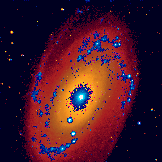 Messier 81 ---
A Bulge-Dominated Spiral Galaxy
Messier 81 ---
A Bulge-Dominated Spiral GalaxyBarely visible with large binoculars, Messier 81 can be found in the constellation of Ursa Major, approximately ten degrees to the northwest of the Big Dipper asterism. At a distance of 10 million light years, it is five times farther than Messier 33 but two times closer than Messier 74. Visual observations with an amateur telescope of moderate size reveal a bright central bulge with a faint disk that is elongated towards the northwest and southeast. This elongation is a consequence of the galaxy's 60 degree inclination from a face-on orientation.
In this composite image of M81, the visible-light component (shown in red-yellow) reveals the accumulation of stars that have formed during the galaxy's 10--20 billion-year lifetime. Except in the outer disk, this accumulation is smoothly distributed with a strong concentration towards the central bulge. In bulge-dominated galaxies like this (of type Sa and Sb), the bulk of the stars are thought to have formed in the first billion or so years following the epoch of galaxy formation. These galaxies are characterized by high central densities, high rotation speeds, little gas at the present time, and low current star-forming activity. The ultraviolet component (shown in blue-white) reveals this most recent activity. Unlike the situations in M33 and M74, the UV-bright knots in M81 are restricted to spiral arm segments well away from the bulge. This spatial segregation may be partly due to the deficit of star-forming gas clouds interior to the arms, which in turn may be related somehow to the massive central bulge of old stars. The bulge itself has a UV-bright component which is thought to arise from hot evolved stars similar to those found in the ancient globular clusters (see Omega Centauri and Messier 79). Further study of giant spiral galaxies such as M81 will help test and refine these suppositions. For example, astronomers still do not know whether the lack of star-forming activity in the central region is governed more by a slow depletion of the gas there or by more rapid changes driven by spiral density waves.
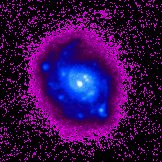 Messier 77 --- A
Barred Spiral with an Active Nucleus
Messier 77 --- A
Barred Spiral with an Active NucleusAt an estimated distance of 49 million light years, the telescopic object, Messier 77, is the nearest example of a galaxy which contains both an active nucleus and intense starburst activity surrounding the nucleus. Each of these phenomena may have resulted from the inflow of gas induced by the gravitational action of the galaxy's central bar. Masking the point-like active nucleus are dense clouds of gas and dust which prevent us from directly viewing the nucleus at optical and ultraviolet wavelengths. Nevertheless, light from the nucleus manages to escape in other directions. After scattering off particles beyond the obscuring clouds, some of the optical and UV photons are re-directed towards Earth --- thus enabling their detection. Spectroscopic observations of these photons reveal that they come from ionized gases with motions exceeding 1000 kilometers per second. If these motions are of an orbital nature, then the mass required to gravitationally bind the orbits is on the order of several million Suns. A supermassive black hole could satisfy the need for so much mass in so little space. Another interpretation lets the motions be unbound and driven by many supernova explosions in the nucleus.
Beyond the point-like central ``monster'', a circumnuclear region of starburst activity has been observed at many wavelengths. In this image, the ultraviolet emission from the circumnuclear starburst is shown in blue-white tints. Intense knots of UV emission are evident along with an unusually bright inner disk. The brightest UV knot approaches the active nucleus in luminosity. It measures more than 2000 light years across and shines with the power of 80 thousand Orion nebulae --- easily dwarfing the 30 Doradus supercluster.
Surrounding the bright knots, diffuse UV emission fills the inner disk --- unlike the situation in more ``normal'' galaxies, where the UV emission is restricted to the spiral arms. Faint diffuse emission is also evident in the form of an outer ``halo'' (shown in purple) extending more than 85 thousand light years across. Were it not for the jet black sky background at UV wavelengths (up to 100 times darker than the nighttime sky at visible wavelengths), this diffuse halo would have gone undetected. The diffuse UV emission from the outer halo and inner disk of M77 is thought to arise from ambient dust in the galaxy which scatters photons from the intense nuclear and circumnuclear sources towards the Earth. If this interpretation is correct, M77's diffuse UV emission is tracing a galaxy-size reflection nebula, similar to that of the Orion nebula as seen at UV wavelengths but 6000 times larger. Even more amazing is that the UV emission manages to escape the galaxy, without being first absorbed by the pervasive dust. This surprising result indicates that starburst activity in other dusty galaxies can be effectively revealed through ultraviolet imaging.
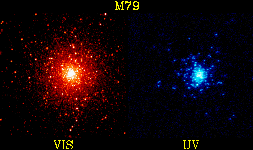 Messier 79 --- An
Ancient Globular Star Cluster
Messier 79 --- An
Ancient Globular Star Cluster Globular star clusters are by far the oldest objects in our Milky Way galaxy. Typical ages for the stars comprising these rich systems range from 12 to 18 billion years --- roughly 3--4 times older than the Sun and planets and embarassingly older than some estimates for the universe itself! During the formation period of globular clusters, the Milky Way galaxy must have looked very different from its current disk-like appearance. Taking their cues from the spheroidal spatial distribution and depleted chemical composition of globulars, astronomers surmise that the primordial Milky Way was almost spherical in shape and nearly devoid of elements heavier than hydrogen and helium. The stellar content of globular clusters provide further clues to the circumstances of their origins and subsequent evolution. By characterizing the light from each star, astronomers can determine the cluster's age and chemical composition, as well as any spatial variations in stellar content within the cluster. Ultraviolet imaging of globular clusters reveals the few stars which are hot and compact, having recently shed their cooler layers. In a few million years (the twinkle of an eye after so long a wait), there will be little left of these once giant stars. The remaining dormant cores contain a Sun's worth of mass within a sphere the size of Earth. These so-called white dwarfs are initially very hot and UV bright, but eventually cool into obscurity. Located in the constellation of Lepus (the Hare), Messier 79 is a globular cluster of typical size and mass. It contains approximately 90,000 stars, many of which are like the Sun in mass, temperature, and color. It also contains many larger, cooler stars known as red giants. Because these commonly occurring stars radiate most of their energy at visible wavelengths, the visible-light image shows many more stars than the UV image. The UIT/UV image reveals those few stars which are finished with their red giant phase and are in the process of becoming white dwarfs --- some by way of a second giant phase. This important transitional period in a star's life is most easily studied at ultraviolet wavelengths, where stars of this type are radiating most of their luminous energy.
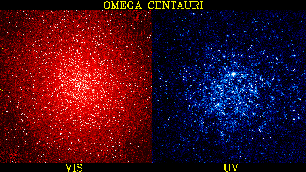 Omega Centauri ---
A Giant Globular Star Cluster
Omega Centauri ---
A Giant Globular Star Cluster Easily visible to the naked eye, Omega Centauri is well-known to observers of the southern sky. Its prominence is a consequence of its relative proximity (17,000 light years) and actual immensity (150 light years across and containing more than one million stars). The visible-light image of Omega Centauri highlights the dense stellar population in this vast and venerable realm. At far-UV wavelengths, the cool Sun-like stars disappear, while the hot post-giant stars shine with high contrast. Most of the UV-bright stars are thought to be blue horizontal-branch giant stars which shine through the thermonuclear fusion of helium into carbon in their cores. The brightest stars probably represent post-asymptotic giant-branch stars which are near the end of their thermonuclear burning lifetimes and are well on their way to becoming white dwarfs. The relative numbers of these different kinds of stars may depend on several factors, including the cluster's age, chemical composition, and degree of central concentration. By comparing the stellar populations of different globular clusters, astronomers hope to reconstruct the histories of these relics, and of the primeval Milky Way galaxy itself.
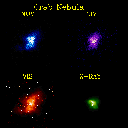 The Crab
Nebula (Messier 1) --- A Young Supernova Remnant
The Crab
Nebula (Messier 1) --- A Young Supernova Remnant In 1054 AD, Chinese astronomers and Anasazi Indian artists (in present-day Arizona) recorded the appearance of a bright ``guest'' star in the heavens. Looking in the same part of the sky (in the constellation of Taurus the Bull), contemporary astronomers find a much fainter and more nebulous object. Number one in Charles Messier's catalog of fuzzy looking objects, the Crab Nebula is recognized today as the brightest supernova remnant in the sky. Approximately 940 years before the Crab attained its current appearance, a massive star exploded with the power of 400 billion Suns. It left behind a rapidly rotating neutron star and a cloud of ejected gases flying outwards at speeds of 1000 kilometers per second (or 2.2 million miles per hour). By observing at a variety of wavelengths, we can see these remnants of the explosion. At the highly energetic x-ray wavelengths, the embedded neutron star beams at us in the form of an x-ray pulsar. The surrounding nebulosity --- evident at x-ray, ultraviolet, and visible wavelengths --- traces electrons whirling in the presence of strong magnetic fields at speeds approaching the speed of light. The magnetically deflected electrons radiate photons in the form of synchrotron emission, similar to the radiation produced in synchrotron particle accelerators. Both the high-speed electrons and strong magnetic fields draw energy from the rapidly spinning pulsar. Currently rotating 30 times each second, the pulsar is gradually but inexorably spinning down --- its rotational energy being transferred to the high-speed electrons which radiate it away. By comparing the near and far-UV images of the Crab's synchrotron emission, researchers have found spatial variations in the ``ages'' of the electrons --- the ``younger'' and more energetic electrons being found closer to the pulsar.
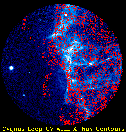 The Cygnus Loop--- An Old Supernova Remnant
Located in the constellation of Cygnus the
Swan, the Cygnus Loop (or Veil Nebula) is the prototype of a supernova
remnant that has evolved into an elegant ``old age.'' Measurements of the
nebula's current size and expansion rate suggest that it has been expanding
for over 150,000 years --- about 160 times longer than the Crab nebula.
Over the eons, the gaseous ejecta have rammed into and plowed up the
surrounding interstellar matter. The resulting pileups now overwhelm the
material from the original explosion. They are evident in the sky as a
broken ring of diaphanous nebulosity measuring more than 3 degrees across.
During the Astro-1 mission, the UIT imaged a portion of the Cygnus
Loop through a far-UV filter that passes the light from Carbon atoms that
have lost 3 of their 12 electrons. Such ions are the collisional
consequences of shock waves that have blasted into the interstellar pileups.
Even hotter gas is present, as shown by the contours of x-ray emission. The
coincidence of the x-ray and UV emitting gasses delineates the
shock-compressed interface between the blast wave (originating from the
right) and the cooler gas in the ambient interstellar medium. By studying
regions such as these, astronomers can better evaluate the importance of
supernovae in shaping the interstellar medium into the froth of filamentary
gas and dust clouds that we see today. Moreover, these regions provide
critical clues to the relationship between supernova blasts and the birth of
stars inside gas-rich clouds.
The Cygnus Loop--- An Old Supernova Remnant
Located in the constellation of Cygnus the
Swan, the Cygnus Loop (or Veil Nebula) is the prototype of a supernova
remnant that has evolved into an elegant ``old age.'' Measurements of the
nebula's current size and expansion rate suggest that it has been expanding
for over 150,000 years --- about 160 times longer than the Crab nebula.
Over the eons, the gaseous ejecta have rammed into and plowed up the
surrounding interstellar matter. The resulting pileups now overwhelm the
material from the original explosion. They are evident in the sky as a
broken ring of diaphanous nebulosity measuring more than 3 degrees across.
During the Astro-1 mission, the UIT imaged a portion of the Cygnus
Loop through a far-UV filter that passes the light from Carbon atoms that
have lost 3 of their 12 electrons. Such ions are the collisional
consequences of shock waves that have blasted into the interstellar pileups.
Even hotter gas is present, as shown by the contours of x-ray emission. The
coincidence of the x-ray and UV emitting gasses delineates the
shock-compressed interface between the blast wave (originating from the
right) and the cooler gas in the ambient interstellar medium. By studying
regions such as these, astronomers can better evaluate the importance of
supernovae in shaping the interstellar medium into the froth of filamentary
gas and dust clouds that we see today. Moreover, these regions provide
critical clues to the relationship between supernova blasts and the birth of
stars inside gas-rich clouds.
 The Ultraviolet Imaging
Telescope
The Ultraviolet Imaging
Telescope Crab
Nebula
Crab
Nebula M74
M74  M81
M81  Omega
Centaurus
Omega
Centaurus  SN1987a
SN1987a
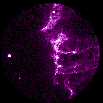 Cygnus Loop
Cygnus Loop
 M82
M82 NGC1317
NGC1317 The UIT homepage
The UIT homepage